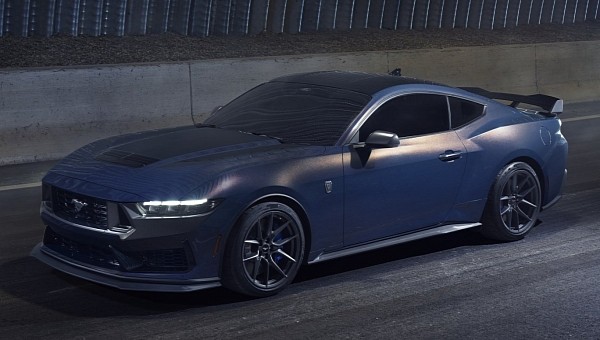When asked how many ponies are hiding under the hood of the Dark Horse, 2024 Ford Mustang chief engineer Edwin Krenz answered, “at least 500 horsepower.” He also promised 480-plus horsepower from the GT, which has a slightly downtuned version of the fourth-generation Coyote.
The primary difference between the third-generation Coyote of the S550 Mustang and fourth-generation Coyote comes in the guise of dual throttle bodies. These 80-millimeter units allow more air to enter the powerplant, resulting in bigger bangs for more power. By comparison, the Mach 1 from the previous generation features a single 87-millimeter unit shared with the flat-plane-crankshaft Voodoo V8-engined Shelby GT350.
Speaking to Evan J. Smith, a.k.a. REVan Evan, the chief engineer of the seventh-generation Ford Mustang, had an interesting thing to say about the GT. “I said 480 horsepower, and I intentionally said plus. The reason I said plus is that we got a competitor sitting at 485, and I don’t like to be second.” That competitor is, of course, the Challenger with the 392 HEMI.
Codenamed Apache and derived from the 5.7-liter Eagle, the 6.4-liter big boy makes 475 pound-feet (644 Nm). Torque figures for the redesigned Coyote aren’t available at press time, but remember that the Mach 1 produces 420 pound-feet (570 Nm) from a displacement of 5.0 liters. Also worthy of note, the biggest difference between the GT- and Dark Horse-spec engines comes in the guise of forged connecting rods. The conrods in question are similar to those in the Shelby GT500's 5.2-liter Predator supercharged V8.
Lower down the spectrum, the Mustang will continue to rely on the 2.3-liter EcoBoost four-cylinder turbo. Minor improvements to the piston dome, shape of the combustion chamber, as well as valve and injector orientation resulted in a slightly higher compression ratio. As opposed to the previous-generation Mustang’s 9.5:1 for the standard tune and 9.37:1 for the High-Performance Package, the EcoBoost in the S650 runs a 10.6:1 compression ratio.
Speaking to Evan J. Smith, a.k.a. REVan Evan, the chief engineer of the seventh-generation Ford Mustang, had an interesting thing to say about the GT. “I said 480 horsepower, and I intentionally said plus. The reason I said plus is that we got a competitor sitting at 485, and I don’t like to be second.” That competitor is, of course, the Challenger with the 392 HEMI.
Codenamed Apache and derived from the 5.7-liter Eagle, the 6.4-liter big boy makes 475 pound-feet (644 Nm). Torque figures for the redesigned Coyote aren’t available at press time, but remember that the Mach 1 produces 420 pound-feet (570 Nm) from a displacement of 5.0 liters. Also worthy of note, the biggest difference between the GT- and Dark Horse-spec engines comes in the guise of forged connecting rods. The conrods in question are similar to those in the Shelby GT500's 5.2-liter Predator supercharged V8.
Lower down the spectrum, the Mustang will continue to rely on the 2.3-liter EcoBoost four-cylinder turbo. Minor improvements to the piston dome, shape of the combustion chamber, as well as valve and injector orientation resulted in a slightly higher compression ratio. As opposed to the previous-generation Mustang’s 9.5:1 for the standard tune and 9.37:1 for the High-Performance Package, the EcoBoost in the S650 runs a 10.6:1 compression ratio.



















